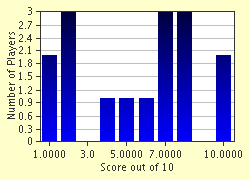Quiz Answer Key and Fun Facts
1. Rough texture produced by knitting all stitches
2. Smooth texture on one side, closely spaced rough texture on the other
3. Stretchy stitch often used for sleeve cuffs
4. Knobby effect produced with unaligned knit and purl stitches
5. Small decorative holes created by combinations of increases and decreases
6. Vertical open-work columns
7. Twisting stitches to produce a raised pattern
8. Using two colors to form a pattern that can only be seen from some angles
9. Multi-color technique in which colors are carried behind the work by twisting
10. Two-color technique that produces a combination of horizontal and vertical stripes
Source: Author
looney_tunes
This quiz was reviewed by FunTrivia editor
WesleyCrusher before going online.
Any errors found in FunTrivia content are routinely corrected through our feedback system.

